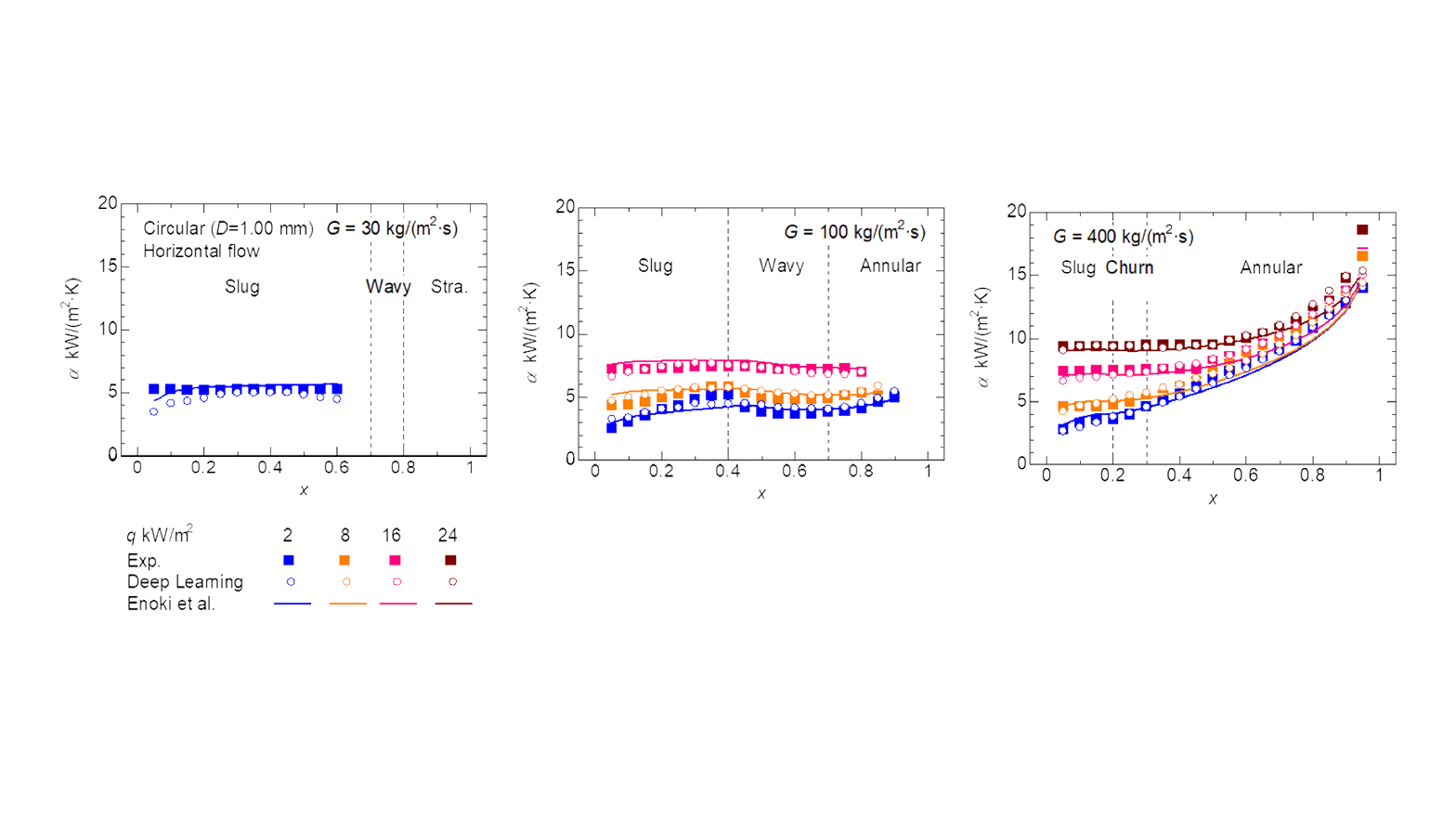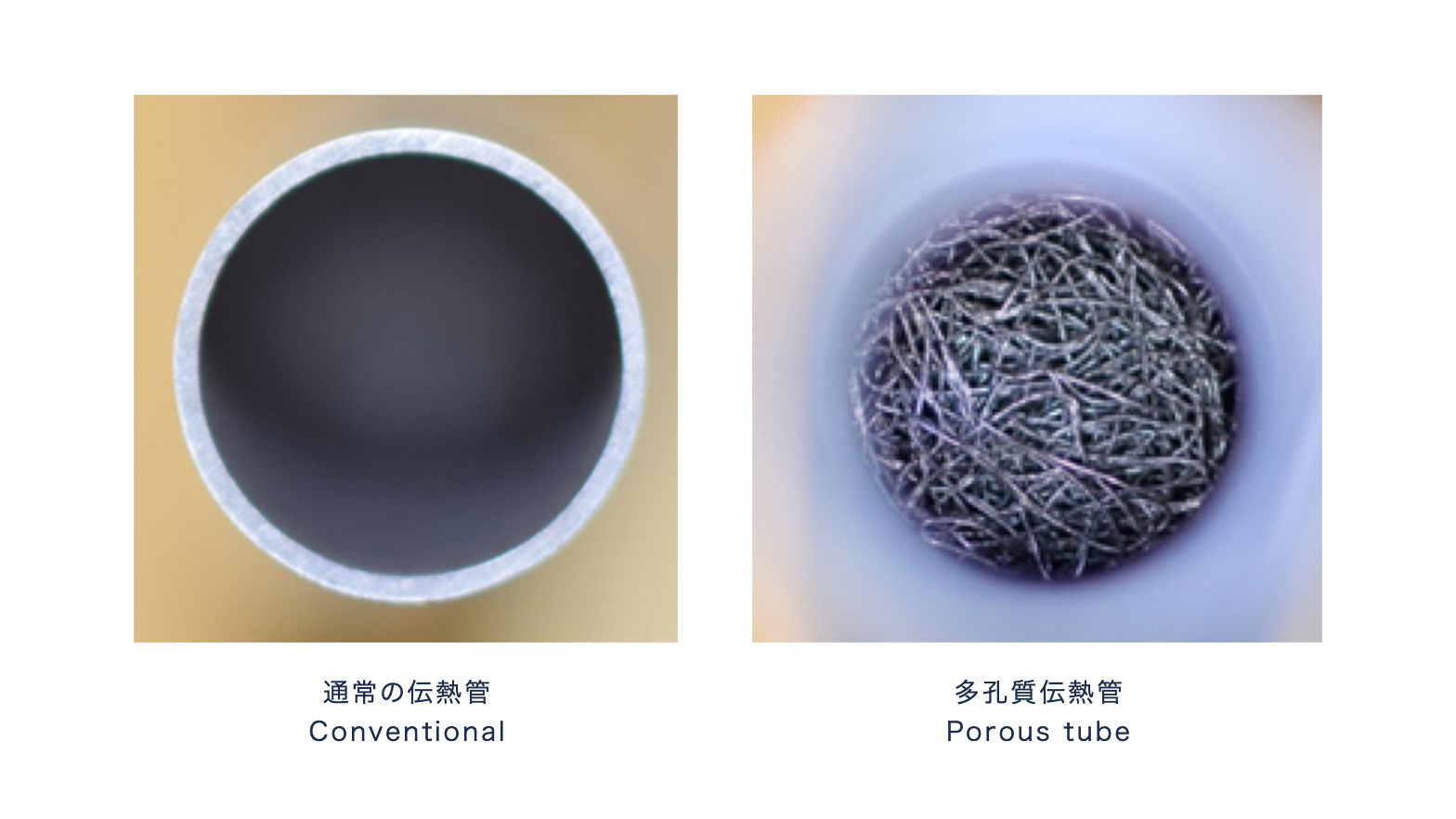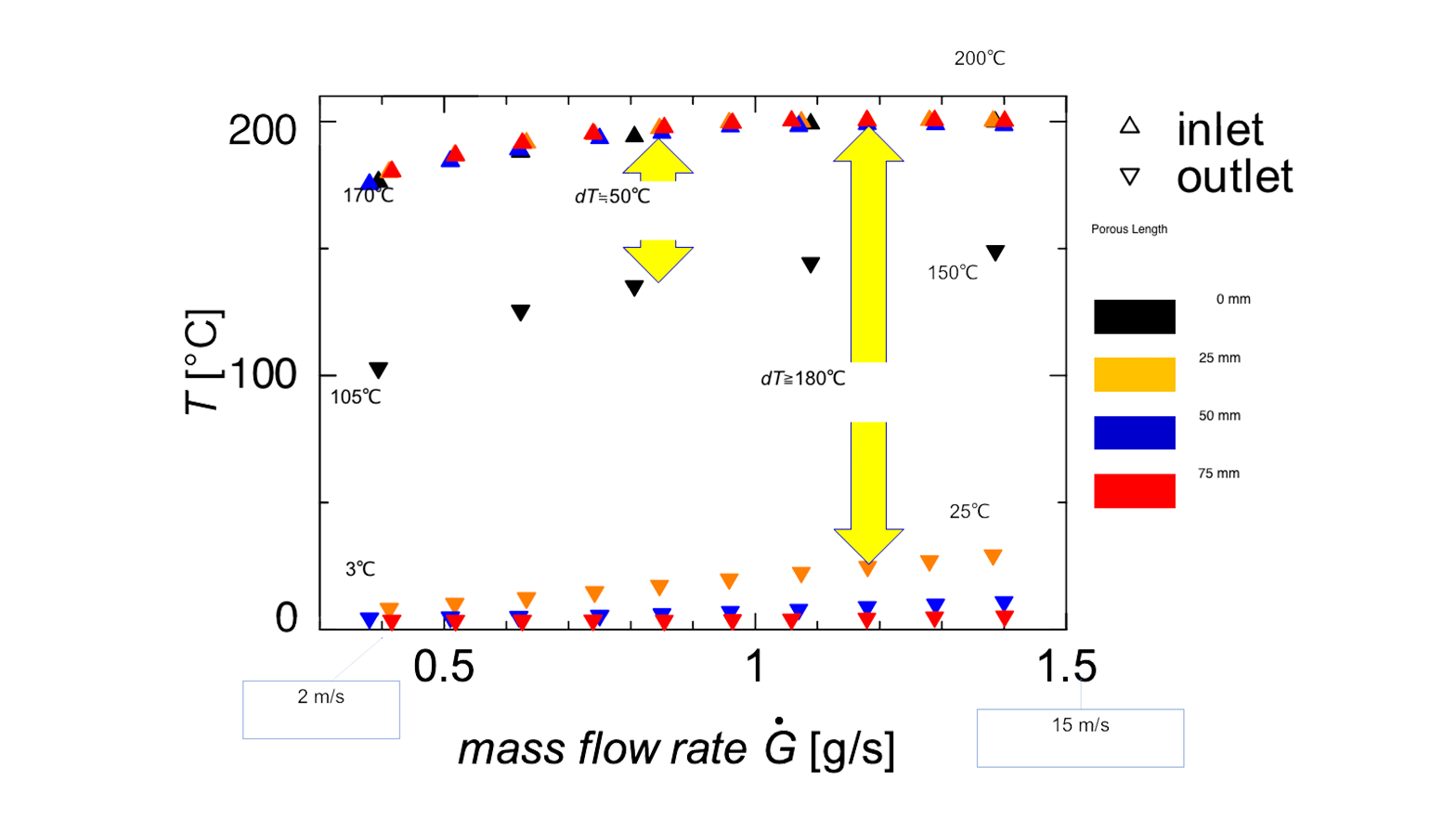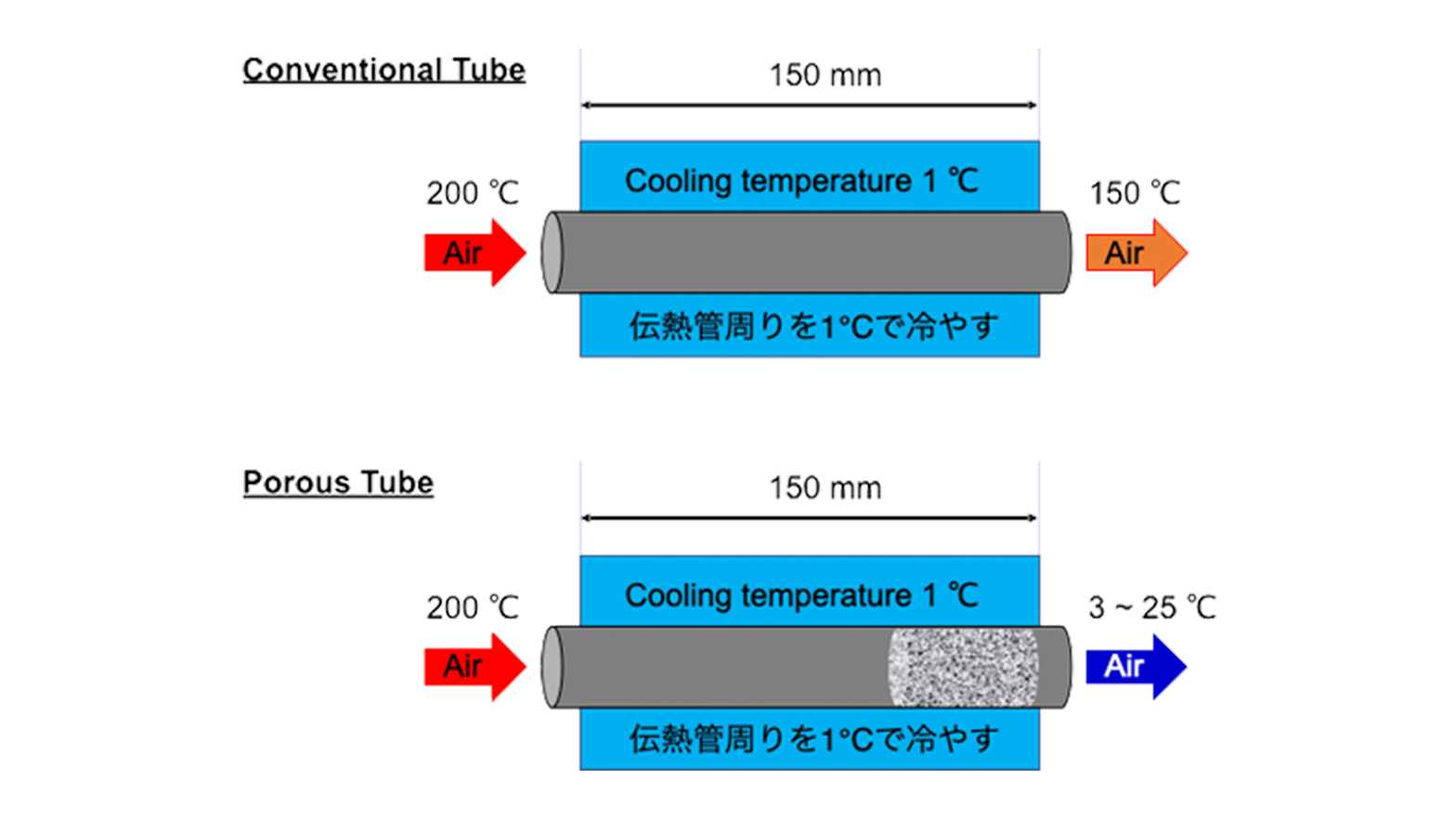keywords: gas-liquid two-phase flow, microchannel, visualization, machine learning
A study to interpret the complex flow phenomena of gas-liquid two-phase flow flowing in a smooth channel with a 1 mm of inner diameter, and to improve the performance of various mechanical devices such as air conditioners, refrigerators/freezers, and automobiles
Figure A-1 shows a high-speed camera of fluorocarbon refrigerant boiling observed inside a heat transfer tube (a part of the heat exchanger) with 1 mm of inner diameter. Figure A-2 visualizes the distribution of refrigerant to the heat transfer tube. Generally, the supply of refrigerant from the heat exchanger header is delivered into the branching heat transfer tube, which installed horizontally. Since it is difficult to uniformly distribute the refrigerant to heat transfer tubes because of the effects of gravitational force and mechanical vibration, this becomes our motivation to work under the research topic. (The red image shows the visualization techniques). The analysis of the physical phenomena through image visualization and formulation allows us to design the types of mechanical equipment with high performance. Recently, we studied the development of physical properties from a large amount of data by using machine learning and artificial intelligence (AI). Figure A-1 shows the predicted values of the heat transfer coefficient (solid line) by developing an empirical equation from the experimental data (■ plot). The highly accurate data can be created from the visualization experiments. Additionally, the predicted values obtained by machine learning (〇 plot) also well predict the experimental data as well as the empirical equation. This research has been applied for cooling and warming blood, such as heart-lung machines.
keywords: porous material, visualization, high-efficiency energy conversion technology depending fluid phase state
Study on industrial waste heat recovery at a temperature of 200 ° C or liquefied natural gas (LNG) at a temperature of - 200 ° C, which discarded now, with higher efficiency and utilized as another energy source.
We investigated the heat transfer enhancement technology by using unique porous material. Figure B-1 depicts the photograph comparison of the cross-sectional area between the conventional tube and the tube with porous material employed in this research. Several types of porous material can be used in the study. In this laboratory, the proposed enhanced porous heat exchanger has the characteristics that the filled porous material made of a similar material to that of a heat exchanger tube, and they are entirely physically bonded and sintered. Figure B-1 shows the photograph of a porous tube that has been bonded and sintered. The big challenge of sintering is that, unlike the conventional ones, the porous body could not merely be packed inside the heat transfer tube, so theoretically, there is no significant contact thermal resistance (in terms of electricity, there is no electrical resistance*1). However, we accomplished a considerable increase in the performance of the heat exchanger in terms of the heat transfer coefficient. Then, Figure B-2 shows the comparison of the temperature differences obtained from the experimental data for the conventional tube with 18 mm of diameter and a 150 mm of total length, and the tube filled with the porous material with the length of 25, 50 and 75 mm with a porosity of 80 % (80 % indicates the ratio of the space inside the heat transfer tube). The inlet temperature of dry air was 200 °C, and the temperature of the heat transfer tube was cooled down to 1 °C in the outlet. Figure B-3 depicts a schematic diagram of the experimental conditions and the results. In the case of the conventional tube, with the inlet of dry air of 150 °C, it provides a temperature difference of 50 °C for the thermal length of 150 mm to the outlet. When the tube filled with the porous material, the temperature difference could reach 180 °C even more. It was performed by a porous tube with a length of 25 mm. For the porous tubes with a length of 50 mm and 75 mm, the air was cooled down up to 3 °C in the outlet of the experimental setup. The heat transfer efficiency of the tube, which filled with a porous material, is the air could achieve a better heat transfer than circulating a large amount of water, with 1000 times higher in density, to remove heat. By using this porous heat transfer tubes, it is possible to recover the heat of around 200 ° C, which previously was discharged from the industries, and use it to recover the cold temperature of LNG at - 200 ° C. For future study, we will use the thermography method, etc., as shown in Fig. B-1 to clarify the physical mechanism of heat transfer enhancement and generalize it so that it can be used for other purposes. We are planning to develop a generalized equation. In the thermographic image, the porous tube is heated from the outside. It can be seen that a fibrous high-temperature field is formed inside the heat transfer tube where a high-temperature area is not normally formed. Finally, the goal is to make effective use of the world's energy using this porous heat transfer tube. (improvement of energy cascade use)
* 1 Considering electricity and heat at the molecular level, the way of transfer is almost the same for both. This relationship is called an analogy, in which voltage is similar to temperature difference, the current is related to heat transfer, and electrical resistance is identical to thermal resistance.
keywords: gas-liquid two-phase flow, subcooled boiling, porous material, visualization
The key performance of improvement the electronic devices, such as aerospace-related equipment, Shinkansen inverters, and CPUs, is how to remove the high temperature generated by this equipment. Therefore, we conducted the research and development of heat exchangers that can efficiently remove heat on a small and large scale
In this study, as introduced on the “Research on recovering industrial waste heat and using it as another energy source,” we investigated the application of heat transfer enhancement technology by using unique porous materials. The difference is whether the working fluid of the heat exchanger is a gas or a liquid, or uses phase change heat transfer with a phase change such as boiling or condensation. Heat transfer with a phase change can transfer heat with high efficiency of 2-4 and 1-2 orders of magnitude for gas and liquids, respectively. In the car radiator, the engine is cooled down by rejecting its generated heat to the water-side while, the water absorbs the heat and undergoes boiling. The boiled water steam flows into the radiator and then rejects its heat to the ambient by condensation process. By doing this, the system keeps a proper thermal condition of the engine. In summer, the air-conditioning system keeps the cabin temperature cool by that of Freon refrigerant absorbs the heat from the cabin with boiling at 10 ° C of evaporation temperature, in the indoor heat exchanger. How much this boiling phenomenon can remove heat is necessary to increase the performance of mechanical devices in the future. Especially, since the generating heat per unit area (or volume) is going to be increased in electronic devices, developing heat exchangers which has a large cooling capacity (with a relatively small-size) is required. Figure C-1 shows the image obtained from a high-speed camera, where the water flows on a heat transfer surface area with a heat flux of 2,000 kW / ㎡ per unit body area, almost the same heat flux as a nuclear power plant. Without any modification of the heat exchanger, the heat load has reached the limit. As we can see from Figure C-1, there is a case where there is no significant amount of liquid on the heat transfer surface at the same time as considerable steam is generated. Additionally, if the working fluid is only gas with poor heat transfer, the heat transfer performance will drop by 2-4 orders of magnitude, and the temperature of the heat transfer surface will be heated to a hundred ℃ in a flash, which causes a failure. Therefore, our laboratory developing a boiling enhancement technology by using a porous material. Currently, it reveals that heat can be removed about 2-3 times. We plan to conduct further research and develop compact heat exchangers that can contribute to high performance in all types of mechanical devices.
keywords: boiling heat transfer, boiling heat transfer of mixed fluid, thermophysical properties, visualization, machine learning
This research is a government-affiliated project in the refrigeration and air conditioning field, which is a vast market. Japan intends to lead this field and create global standards. The research institutes of the project include Waseda University, University of Tokyo, Kyushu University, National Institute of Advanced Industrial Science and Technology, etc. The details of the research contents are as follows. Currently, CFC alternative refrigerants used in refrigeration and air conditioning systems do not affect ozone depletion but contribute to a high global warming potential (GWP), and their use will be banned gradually in the future. For this reason, new refrigerants should be proposed. Therefore, as a global trend in the research of new refrigerants, we aim to develop the new refrigerants by mixing two or more types of refrigerants with different properties with the merits that this new refrigerant can compensate for any demerits it has. On the other hand, there is also a problem that the boiling phenomenon becomes very complicated, for example, since the mixed substance which quickly boiled is vaporized first, the physical properties of the mixed refrigerant can be changed locally. When designing a next-generation refrigerant and air conditioner, it is necessary to clarify this complex boiling phenomenon. Therefore, in the current project, our laboratory at the University of Electro-Communications built a generalized formula by elucidating the physical mechanism of this complex boiling phenomenon while conducting comprehensive experimental and theoretical research. We are investigating to establish global standards so that heat exchange devices, that meet the requirement, can be developed by integrating them into control devices.
keywords: Trivia, Importance of seeing, Slow video function of iPhone,Free study, Visiting lecture
Figure A-1
Figure A-2

Figure A-1

Figure B-1

Figure B-2

Figure B-3
Fig. B-1
Figure C-1
q = 2,000 kW/㎡ (Almost same heat flux as a nuclear power plant)